#kuroda kanbei
Explore tagged Tumblr posts
Text
Why Samurai Lords hates Ishida Mitsunari
Ishida split the Toyotomi Clan as he only wants the Taiko to trust him and no one else.


Ishida proposed the idea of holding the lord's families as hostages to prevent uprising knowing that the lords hates him


Ishida openly disrespects other lords despite of their experiences, contributions and loyalty displayed to the Taiko.

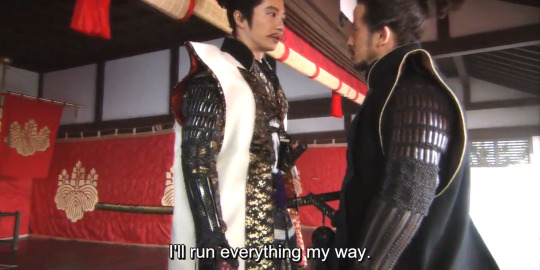
Ishida manipulate the Taiko into breaking his promises with his allies and former enemies, making more enemies along the way


Ishida criticizes those who opposes his decision by telling them that to oppose him is to oppose the Taiko which deserves a punishment


Instead of providing proper logistic support being an administrator, Ishida is only there to report their shortcomings to the Taiko


Although it's his fault for not ensuring proper logistic supply which caused them to retreat, he blames them for failing and retreating


Instead of reporting the truth to the Taiko, he changes his report to save himself while throwing all the lords under the bus to be blamed


All the while, the Taiko himself is totally oblivious of the real situation thanks to Ishida's false reports while his Samurai are suffering


The Taiko even send ridiculous conditions which will prolong the war instead of ending it as he thinks he still have the upper hand


The only person who listens to the Samurai lords is Tokugawa Ieyasu who have been against the war since the beginning like the others


While the Samurai are suffering in Imjin War due to Ishida Mistsunari incompetence and false report, the oblivious Taiko is enjoying himself.
It's no wonder the Samurai lords who serves the Toyotomi later switch side to the Tokugawa during the Battle of Sekigahara.
Strategist Kanbei / Gunshi Kanbei (Ep 38 - 42)
#strategist kanbei#gunshi kanbei#toyotomi hideyoshi#ishida mitsunari#kuroda kanbei#kuroda nagamasa#tokugawa ieyasu#period drama#taiga drama#historical drama#japanese drama#sengoku jidai#jidaigeki#japan#sekigahara#imjin war#samurai invasion of korea#okada junichi#junichi okada#tanaka kei#kei tanaka#matsuzaka tori#tori matsuzaka#fumi nikaido#nikaido fumi#chacha#yodo dono
17 notes
·
View notes
Photo

Beat Takeshi stars as Hideyoshi in “Kubi” 首, a movie where he’s also involved in the scriptwriting, and also is the director!
To think that this showed up not long after I shared that old Toyota advertisement! However, unlike the more positive Hideyoshi image in the Toyota ad, the PR of this movie says that the plot follows the “Hideyoshi is the mastermind behind Honnouji” conspiracy. So we can expect a scheming, or even a somewhat sinister Hideyoshi in this production.
加瀬亮 Kase Ryou will play as Nobunaga, 西島秀俊 Nishijima Hidetoshi as Mitsuhide, 浅野忠信 Asano Tadanobu as Kuroda Kanbei, and 大森南朋 Ōmori Nao as Hideyoshi’s brother Hidenaga.
It’s always a little strange to me, to see a ridiculously old Hideyoshi when the actor cast as Nobunaga is much younger, but it’s a thing that’s very commonly done in Japanese live action productions and illustrated artwork.
#kitano takeshi#beat takeshi#movie#live action movie#oda nobunaga#honnouji incident#Honnouji#Honnoji#Akechi Mitsuhide#hashiba hidenaga#Hashiba Hideyoshi#toyotomi hidenaga#Kuroda Kanbei#kuroda kanbee#kuroda kanbei yoshitaka#kuroda yoshitaka#kubi
18 notes
·
View notes
Text
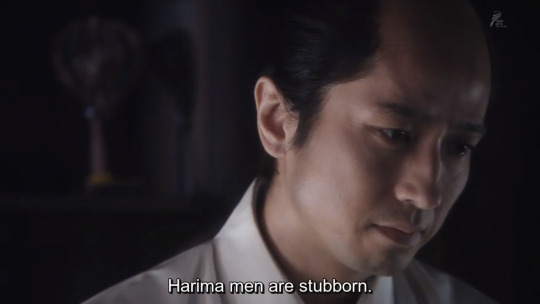
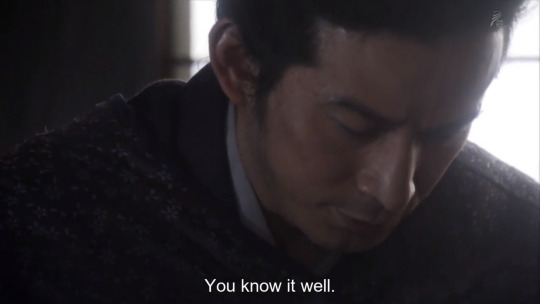
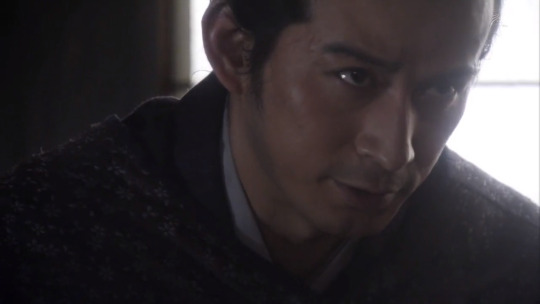
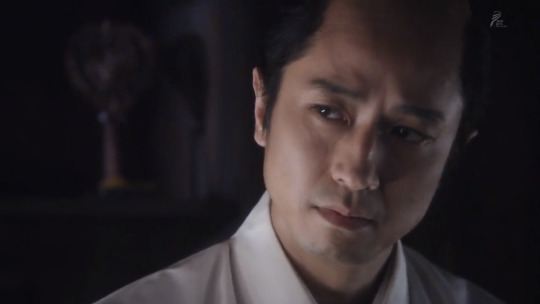
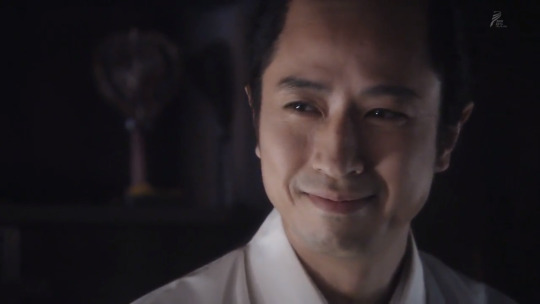
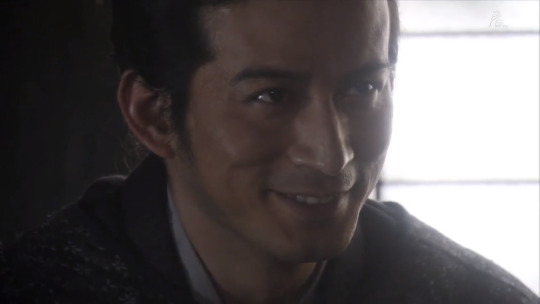
help
Gunshi Kanbei (2014), ep. 19.
#helppp#i love them#kanbei is always near hanbei when he is sick#this is literally an episode before our beloved kanbei gets imprisoned#beloved#this is getting out of hand i am making my personal gallery of taiga drama moments at this point#nhk#nhk drama#japan#japan history#gunshi kanbei#gunshi kanbee#軍師官兵衛#大河ドラマ#nhk大河ドラマ#kuroda kanbei#hanbei takenaka
5 notes
·
View notes
Photo

Artwork by 悠人
Written permission personally granted by the Artist Don’t repost without permission or remove credits. ◆ Please, rate this artwork on the Artist’s Gallery~
#戦国BASARA#Sengoku Basara#BASARA Fanart#With Permission#4920932#Kuroda Kanbei#黒田官兵衛#Goto Matabei#後藤又兵衛#Duo
1 note
·
View note
Text
One of my first (but hopefully not last) contributions to the emerging trivia on Shôgun:
Lady Ochiba / Ruri, the mother of the Taiko's heir Yaechiyo, is based on Lady Yodo/Chacha (1569-1615), niece to Oda Nobunaga and second spouse of Toyotomi Hideyoshi. We see her here as the primary moving force shoring up her son's position and the patron of Toranaga's rival Ishido.

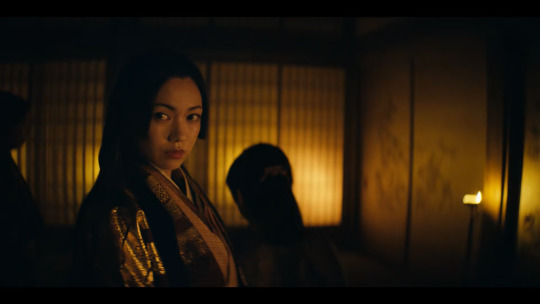
Fumi Nikaido as Lady Ochiba, Shôgun, 2024
What makes the casting of this one very interesting is that Fumi Nikaido has played the actual role of Yodo/Chacha in a similar period production, the 2014 NHK taiga drama Gunshi Kanbei (which was primarily about Kuroda Kanbei, the strategist of Hideyoshi played by Junichi Okada).
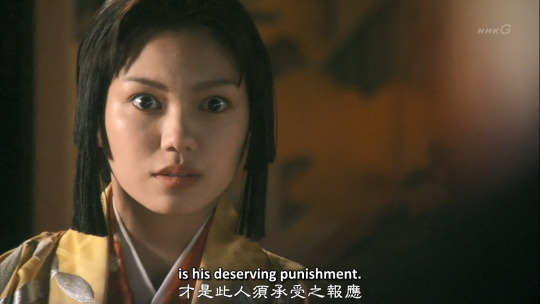

Fumi Nikaido as Yodo, Gunshi Kanbei, 2014
While there's enough hype for Toranaga (especially as he is portrayed by public favorite and producer Hiroyuki Sanada--rightfully so), I wish to highlight Fumi Nikaido's return to this role as it does help highlight the differences between how Lady Yodo is portrayed in fiction. (It does help that we have no shortage of it now--even if it's mostly in videogames like Samurai Warriors, Sengoku Basara or the more historically-faithful Nioh).
The material we have of Lady Ochiba so far is of a proud, haughty, even disrespectful woman--and perhaps it's not exactly far off from how Chacha is portrayed even in Japanese media. To some extent, even Gunshi Kanbei conceded to this especially in the episodes I'm referring with this photo--what with it precisely being the moment Yodo is fearing coming to pass. A mother seeking to protect her son's patrimony (and by extension, her agency and regency), it's a universal trope in feudal drama. What Shôgun does not give her yet (but Gunshi Kanbei took pains to establish) is the recognition that she is as much a victim of the warring era, turning her into a self-loathing monster only able to survive trying to make sense of it all, and maybe recover their agency in it. Clavell rightfully gave it to his main focus character, Lady Mariko (played very layered and well by Anna Sawai compared to her more recent outings--herself based on Hosokawa Gracia).
It truly amazes me that 10 years has yet to make much of a difference for Fumi Nikaido and this role. The woman whose position at the top was only made possible by misery and her playing by the cruel game of chaos, she portrays both versions with the edge, anxiety and palpable will of a woman who's lost everything before and is at the doorstep of losing them again.
#shôgun#shogun#samurai#shogun fx#shôgun fx#shôgun 2024#shogun 2024#fumi nikaido#chacha#lady yodo#yodo-dono#ochiba no kata#james clavell#lady ochiba
133 notes
·
View notes
Note
Did Mitsunari Ishida screw up Sekigahara?
I think you can blame Mitsunari for the defeat at Sekigahara, not necessarily for his battle plan (which was actually fairly solid), but for his inability to manage his subordinate vassals. The Western Coalition was notorious fractious. Shima Sakon and Shimazu Yoshihiro were at loggerheads and Mitsunari refused to listen to Shinazu's complaints, leaving Shimazu ripe to be persuaded by his nephew Toyohisa to sit the battle out given that Tokugawa was more palatable as a leader. Other Toyotomi heavyweights were likewise alienated by Mitsunari - Kato Kiyamasa, Fukushima Masanori, and Kuroda Kanbei - all of whom Mitsunari made unflattering comments about when discussing their military readiness with Hideyoshi back when he was alive. Kobayakawa Hideaki was demoted on the personal recommendation of Mitsunari, which left him embittered, but then Tokugawa Ieyasu intervened personally to spare his career.
It's also worth noting that Mitsunari was not a member of the hereditary noble class. So for many of the older and prouder samurai, they were massively pissed at the idea of obeying this up-jumped bureaucrat.
Thanks for the question, Cle-Guy.
SomethingLikeALawyer, Hand of the King
13 notes
·
View notes
Text
Koei Warriors Retrospective Part 14: Samurai Warriors 3


Samurai Warriors 3 (戦国無双3) Platforms: Nintendo Wii Release dates: Japan: 3 December 2009 USA: 28 September 2010 Europe: 28 May 2010
While Alec and Shanna were busy on their assignment, Azuma Yeonchi was waiting for his interdimensional friends, Hiroki, Sougo and Polvina, to find a way to get them to Yabuverse PM10. The Kwisatz Haderach had been made aware of this and agreed to allow them leave to help Hiroki once he was ready for them to head over. For now though, Azuma had a new instalment of the Koei Warriors Retrospective to do.
A theory - Koei Tecmo's exclusivity deal with Nintendo killed English dubs in Koei Warriors games. I'll explain later in the instalment.
By this point in time, Koei had spaced out the time between new instalments of Warriors games; SW2 was released two years after SW1, DW5 was released two years after DW4, DW6 was released nearly three years after DW5, SW3 was released nearly four years after SW2, and WO3 would later be released nearly four years after WO2. The main reasons for this included them alternating between their three main series, Omega Force working on other Warriors games unrelated to their three main series, and of course all the spinoffs in between.
Dynasty Warriors had entered the modern era with 6, so it was time for Samurai Warriors to do the same with 3. With it, however, came the start of Koei Tecmo's weird and shortsighted decisions that set them down a downward spiral for the Warriors series as a whole. Come down the spiral with me and I'll try to make sense of everything for you.
Samurai Warriors 3
For some reason, this game was initially released on the Wii instead of the PS3 and Xbox 360 despite reception for Katana being rather poor. As I said before in DW6, the PS3 was more expensive compared to the PS2 at launch. I also didn't tell you that it was also more expensive than the Xbox 360 at launch, but the two consoles ended up being undercut by the Nintendo Wii, which was cheaper than the two consoles when it launched just after the PS3. While the lower computational specs (on par with the original Xbox) and lack of HD support contributed to its lower launch price, the innovative motion controls served as a gimmick that appealed to non-hardcore gamers.
Naturally, the Wii outsold the PS3 and Xbox 360 year after year, making it the most popular console globally. According to executive officer Yoshiki Sugiyama and producer Hisashi Koinuma at the announcement press conference, there was demand for a Wii release from the development team and so they hoped that they could reach a wider audience with it, neglecting to consider what consoles their fans mostly played Warriors games on. In a surprise appearance from Shigeru Miyamoto, he recalled that Koinuma directly appealed to him for permission to adapt the 1986 Famicom Disk System game The Mysterious Murasame Castle into the game, which he granted. We'll come back to that.
Let's take a look at the characters. For the most part, the cast from SW2XL do return in this game, with some exceptions. Goemon Ishikawa remains cut but Kunoichi returns with a new design and Musou kanji. Gracia, Musashi and Kojirō are cut from this game as well. Of the remaining newcomers from SW2XL, only Motochika has a Story Mode in this game, meaning that Toshiie Maeda and Katsuie Shibata do not. Nor do Yoshimoto, Kotarō, Nō, Ranmaru or Okuni.
Oichi also receives a new design and weapon in this game, with her moveset type being changed from the Normal Attack moveset back to the Charge Attack moveset. Her weapon in SW1 and 2 was the kendama and her new weapon is the chained chakrams. These changes were made to reflect her maturity, coming off her initial youthful appearance in the first game.
The new characters debuting in this game are as follows:
Kai
Kiyomasa Katō
Kanbei Kuroda
Ujiyasu Hōjō
Muneshige Tachibana
Hanbei Takenaka
Motonari Mōri
Aya (NPC)
Masanori Fukushima (NPC)
Aya and Masanori's character models can be used for CAWs by clearing Kenshin, Kanetsugu, Mitsunari and Kiyomasa's Story Modes.
Where the last game introduced clans outside of the Oda, Takeda and Uesugi, this game expands on them and also adds some more playable characters for the final battles at Sekigahara and Ōsaka. Ujiyasu's inclusion completes the Kai-Sagami-Suruga Alliance between the Takeda, Hōjō and Imagawa and the Kantō Three Kingdoms rivalry between the former two and the Uesugi.
Story Mode and Free Mode remain in a similar format to SW2. Each Story Mode has five individualised stages without the Gaiden/Dream stages at the end, and Free Mode uses one character's stage for each battlefield/force for the most part. For the character you choose in Free Mode, if the stage you select exists in their Story Mode, then their version takes priority (SW2 also did this but on a smaller scale). If the stage doesn't exist in their story mode but they are featured as an ally in the stage, then they will appear as a duplicate officer (eg. The Battle of Tedorigawa Oda Army scenario as Nobunaga using Motochika's scenario, or The Battle of Shizugatake Hashiba Army scenario as Hideyoshi using Kiyomasa's scenario).
This game begins the trend of Samurai Warriors games being mission-centric. Each battle will have 4-6 missions/objectives, sometimes overlapping with each other but for the most part, they happen one after the other.
In addition to this, there are also Tactical Bonuses that can affect the battle or allow you to gain rewards. There are various types of such objectives, but the bottom line is that you have to defeat the objective officer by yourself to obtain the bonus. Given the tendencies of the allied AI, you are prone to having your kills stolen by other allied officers and failing to achieve the objective. Achieving all four Tactical Bonuses in a stage will fully clear it, and doing the same for all five stages in a characters' Story Mode will give you the gold Clear. This is also the key to obtaining the rare weapons when you play the specified stage for the character in Hard difficulty or above (in Story Mode only for playable characters).
One of the most egregious types of Tactical Bonuses involve those where you have to defeat an officer (or even a stronghold Guard Captain) with a hit chain count above (or below) a certain number. It's hard enough trying to rack up combos with the battle mechanics as they are when the hit chains hold for as long as the combo chains did for the combo points in DW3. There are ways to mitigate this (have the Eternal Fist 連撃 skill on your gauntlets and use the Mystic Crystal in conjunction with the Book of Secrets if the battle has them), but it's an absolutely bullshit limitation when the focus of Warriors games in the modern era seems to prioritise stuffing more enemies on the screen and hitting masses of enemies in one attack. Another egregious example involves those where you have to defeat an officer with your health in the red. Given the behaviour of the enemy AI, it's either a very slow prospect on lower difficulties or a very risky prospect on higher difficulties.
Murasame Castle is Samurai Warriors' remake of the aforementioned Nintendo game, hence this mode was made in collaboration with Nintendo and is exclusive to the Wii games. I didn't play this because I didn't want to set up another emulator, so it's all up to impressions here.
This mode acts similar to the Survival Mode of older games, while the level selection map is reminiscent of SW2's Sugoroku. The story has you travelling to four castles and defeating their lords to obtain their jewels before fighting the final boss in Murasame Castle. It can get really challenging when you get up to it, so it helps to have powerful characters and weapons.
Each stage of Murasame Castle has three tanukis that when purified (by destroying them) allow you to obtain rewards, including the Matsukaze Harness. After clearing this mode once in Normal Mode, you can play it again in Nightmare Mode. Purifying tanukis in Nightmare Mode will allow you to unlock the four lords' models to use for CAWs along with the Bear Harness.
Takamaru is featured exclusively in this mode as the main character of the original game, using the generic/sword moveset with slight modifications. He can be unlocked for use in Free Mode by purifying 33 tanukis. There are also three bonus Takamaru-exclusive stages that will allow you to obtain rare items when cleared. Although Takamaru is voiced, most of Murasame Castle is unvoiced save for the voice lines already used in the rest of the game.
Historical Mode is a mini-Story Mode exclusive to CAWs that has you playing a series of battles in different stages of the Sengoku period's history. There are three chapters consisting of five stages each. After clearing a stage, details in the timeline will unlock themselves depending on the score you achieved in battle. This mode was sold as DLC in Japan for 300 yen per chapter, but is included for free in Western releases and 3Z.
The Dojo is where everything else is now. Throughout the game, you will earn rice currency (in tonnes) which can be used to unlock bonuses for each character, including usability, colour editors, max stats, galleries (in XL and Z) and the use of that characters' weapons for edit characters. Most of those bonuses are unlockable when you clear their Story Modes.
I mentioned colour edits for characters and yes, it is just as it says on the tin. Parts of characters' models/costumes can be colour swapped, making for an interesting experience when you take them into battle.
Up to 20 edit characters can be created, and while the parts do resemble those seen on generic officers, the characters you make don't have to be the same as them, unlike SW2 (especially for female characters). The base model you select at the start is really a preset as you can mix and match models of your choice by going through the menus (in fact I'm pretty sure that's how generic officers also work in the modern era). The customisation options are still limited, but it's better than it was in previous games. Unfortunately, you are unable to set the Musou kanji for your character as it is determined by the weapon you give them.
When naming your character in the Japanese version, the name and surname fields are merged into one field unlike previous games, plus you can also define the furigana that will be displayed for them in the officer list.
For the most part, the battle mechanics remain the same as used in SW2XL, though some changes have been made as always; Special Skill-type characters retain the use of two Special Skills, but when holding down -/R/R1, the stance is removed as you perform a default skill automatically, though you can press Square to boost it or Triangle to use the second skill.
The Spirit Gauge is a new addition to this game. Performing attacks will fill up to five units of the gauge. With this, you can cancel out an attack with a Spirit Charge, which consumes one unit of the Spirit Gauge to charge forward and break enemy guards.
The three-level Musou Gauge from the last game is replaced with three separate gauges. Using a Musou Attack uses one of those gauges for a set duration, except if you use the Mystic Crystal, which fills your Musou Gauge and lets you use a Musou Attack for at least 15 seconds before a gauge is emptied. With a Spirit Gauge fully filled, your Musou Attack will become an Ultimate Musou Attack, adding a finisher at the end when the gauge runs out. The Ultimate Musou Attack uses the kanji for the True Musou Attack.
All characters now have the ability to summon their horse, a feature carried over from Warriors Orochi, and can also sidestep in four directions by pressing C/B/Cross while blocking and strafing.
Weapons are now categorised into Normal, Power and Speed types similar to DW6, but the implementation is akin to the weight system used in DW5. Weapons can also have one of five elements like in SW2. Rare weapons are also available as stated and they also fit into one of the three categories, with the increased weapon power essentially moving it up a category.
Aside from your weapon and horse, there are three new types of equipment you can equip, including armours, gauntlets and boots. Armours augment your defence, gauntlets augment your horsemanship and weaponry, and boots augment your speed. Of the 25 abilities available to weapons and 15 abilities available to other items, you can have a maximum of six which are randomly determined when you obtain them. A maximum of eight of each item can be kept, the weapons being separate for each character and the other items being shared among all characters. All horses have fixed stats and are retained as you obtain more of them.
Weapons and equipments can be upgraded at the Blacksmith, which serves as the replacement to the Shop. Abilities can be upgraded to level 3, but each piece of equipment has a limited number of times you can upgrade them (up to a maximum of 9). Rare items cannot be upgraded. Instead of gold, you obtain gems and crystals which are used to upgrade equipment. Typically, upgrading an ability to level 2 requires 5 gems (8 gems and 2 crystals for rare abilities), while upgrading to level 3 requires 12 gems and 3 crystals (19 gems and 7 crystals for rare abilities). The combinations will vary depending on the equipment and ability to be upgraded, but typically weapons mainly use red gems, armours use green gems, gauntlets use yellow gems, and boots use blue gems.
With the focus on gems used, it can be easy to run out of a particular type of gem, and with the limited number of times you can upgrade a piece of equipment, you have to put careful consideration into what you want to upgrade. Personally, with the varying combinations of gems and crystals required to upgrade abilities, I'd scrap the upgrade limit and put limits on what levels that abilities can be upgraded to.
Battle Items have been introduced in a mainline Samurai Warriors game after being used in Katana. At the start of each battle, you are required to select one of three item sets that you will use in the battle. "For the cautious warrior" always consists of 3 Dangos and 3 Rice Bowls and is designed for those who want to play it safe. "For the confident warrior" is designed for those who want to balance playing it safe with achieving Tactical Bonuses, and "For the ambitious warrior" is designed for those who are confident in achieving Tactical Bonuses. The items in the latter two categories are different between each battle and two-player mode adds two unique and exclusive items designed for two-player gameplay.
With the game being on the lower-spec Wii (compared to the PS3 or Xbox 360), the gameplay is notoriously affected by it. There are some games on the Wii that can run at the standard 60fps and there are those that run at 30fps. This game is one of the latter and as such, slowdowns and sluggishness are noted to occur, particularly if you're using a Power weapon that has a slower attack speed. The game being on a dual-layer DVD as well doesn't seem to help, particularly if there is dust on the reader lens, though I presume the situation wasn't as bad as it was on the PS2.
Also, given that this game requires at least a Wii Remote and Nunchuk to play, if not the GameCube Controller, the controls can feel a bit clunky compared to if you were playing on a PS3 or Xbox 360. The Classic Controller (Pro) can also be used, but because you have to connect it to a Wii Remote in order to use it, it's only slightly less clunky (imo, I never played this on an actual Wii) than if you used the GameCube Controller.
No morale bar is seen in battles and the strength of allied and enemy officers is determined by how much attack and defence power they have, which can be seen in the officer list. I'm not sure if there is a correlation, but a notorious quirk is that there are allied officers who are weak enough to be easily wounded or defeated, as if them struggling against enemies at 90% health is bad enough. Either that or they're suddenly strong enough to steal your kills when you're trying to obtain Tactical Bonuses. You can use your items to heal your allies if you're near them, but that only buys them some time. Apparently, allies are less likely to retreat on higher difficulties, but enemies are strengthened as well so you are more likely to be defeated.
Enemy AI is more aggressive even on Novice/Easy difficulty, so officers tend to guard a lot, attacks from soldiers can break your combos, and there are times when your character will get juggled into the air repeatedly, particularly when you are surrounded by enemy officers. These issues can somewhat be mitigated when your character is levelled up enough and you have a decently strong weapon, but these reasons, when compounded, are part of the reason why this game can feel frustrating to players, particularly when initially playing characters and developing their levels and weapons.
Announcements have also been added to this game, alerting you when gates are opened or closed, when units begin advancing, when an objective officer requires assistance, or when victory or defeat conditions change. Given how the Wii was made to appeal to casual gamers, I can see how this would have benefitted them.
GACKT was also involved in this game as he sung the theme songs 雪月花 -The end of silence- and 斬~ZAN~. GACKT was also a surprise guest at the announcement press conference, having been invited by Koinuma in an effort to have a big name stir up promotion for this game. This was also in the year when he was releasing theme songs for the recently-concluded Kamen Rider Decade. GACKT had also played Kenshin Uesugi in the 2007 NHK Taiga Drama Fūrin Kazan (風林火山) and had released the song RETURNER~闇の終焉~as a sort-of tie-in, with the music video showing him wearing the same armor he wore as Kenshin in the drama. You should also check out his performance of the song in the 2007 Kōhaku Uta Gassen as well because it's fucking awesome.
Anyway, 雪月花 can be heard in the credits of Murasame Castle in the Japanese release; it is not used in Western releases and in Z, it is available in the Sound Test section of the Settings menu after clearing a Story Mode. 斬 can be used as background music during battles; after clearing Kenshin's Story Mode, start a new battle and hold down the Z/X/Triangle buttons as you select Start Battle. I'm not sure if this is also available on Western releases though.
As I previously stated, most of the English voice cast for the SW characters in Warriors Orochi reprise their roles for this game, with some characters being recast for one reason or another. Unfortunately, for another reason and even more, this would be the last Samurai Warriors game to be dubbed. That rant will come in time.
Samurai Warriors 3 Xtreme Legends (Sengoku Musou 3 Moushouden)

Samurai Warriors 3 Xtreme Legends (戦国無双3 猛将伝) Platforms: Nintendo Wii Release dates: Japan: 10 February 2011
If you wanted any proof that Xtreme Legends expansions and Mixjoy functionality can be possible on non-Sony consoles, this is it.
So unsurprisingly, Samurai Warriors 3 gets an Xtreme Legends expansion. Gracia returns to the series and gets a Story Mode along with the 9 others who did not get one in the vanilla game, including Aya and Masanori, who also get unique weapons as well. Murasame Castle is available for use without Mixjoy, plus online play is available for all stages except the three Takamaru-exclusive stages. Novice and Nightmare/Hell difficulty are also available along with secondary rare weapons, which are the same type as the primary rare weapons, can boost your stats for 10 seconds every 100 KOs and are only obtainable on the Nightmare/Hell difficulty.
Original Career Mode is a new mode introduced in this expansion, similar to the Xtreme Modes of DW4XL and DW5XL and the Mercenary Mode of SW2XL. This is a sandboxed mode where you develop your character from scratch and guide them on a path focusing on might, intellect, wealth or unification (available after clearing the mode once).
Your character starts with 10,000 gold plus 10% of their total EXP value. You are then given a goal to achieve within a certain amount of days by playing battles. Battles are 15 minutes long but can be extended to 20 with an item from the shop (which only applies for the first battle of each day). You can play as many battles as you want in one day before returning to save your game or restock your items, which ends the day. Different objectives and Tactical Bonuses are available in each battle.
The EXP you gain from each battle is converted to gold with a different conversion rate for each one, which gets higher as time goes on. Recovery items are a rare occurrence in this mode (even with an item that apparently gives a higher chance of them appearing), so you need to be mindful of what you use and when. Having the Roaring Beast (破竹) skill on your gauntlets also helps as well as you can recover a portion of your health every 100 KOs.
After the due date for the goal has elapsed, you will participate in a 25-minute randomised main battle throughout history, beginning with Okehazama. Following this, you get a new goal and you rinse and repeat until you get to Sekigahara, then you can do it one more time to finish with the Ōsaka Campaign.
Before going into battle for the day, you can use the blacksmith to upgrade your weapons and equipment, and you can also use the shop to purchase items and hire other officers to accompany you in battle (remember that items that take effect in battles only do for the first battle of each day). Different items are available each day and you can't sell items to buy other ones, so be sure to choose carefully. Aside from consumable items, you can also buy support items. Some support items give you missions to rescue or protect someone, some items give you a merchant to visit who will give you double the price you paid for the item, and some items boost or nerf your stats. Levelling up is also done through the shop as well, so you also need to be mindful of this as battles will get harder as the mode goes on.
Up to a maximum of 3 officers can accompany you in battle and you can have 2 more in reserve. As they play battles, their level will go up to the maximum of 5. Officers can be captured as well during battle. When you have an officer during battle, they can rally your party and boost a stat for 30 seconds, give unlimited Musou for 10 seconds or fill your Spirit Gauge.
After the second main battle, you will have an officer who will become your friend and an officer who will become your rival. Fighting your rival will become important in the unification scenario as it is one of the final goals.
While you can achieve the targets of each goal for a normal completion, you can also achieve a second goal that is 60% more than the original goal to achieve mastery of that goal. This mode is also where you earn the rare items obtained in Murasame Castle and is hence an alternate method for the Wii version; completing the might, intellect or wealth scenarios gives you the rare item from the Normal difficulty, completing all goals in the scenarios gives you the rare item from the Nightmare difficulty, and mastering all goals gives you the third rare item exclusive to the expansion (but not with the Nightmare item at the same time so you will need to replay it). The equivalents for the unification scenario are the Matsukaze Harness, the Bear Harness, and a random unique rare item (that is if you're schizo enough to find and defeat your rival 13 times for the final goal, which you may get beyond the 19 victories you need).
When you decide to end the scenario, you will need to choose the weapons and items you want to keep for use in the rest of the game, but your character's stats aren't affected.
Original Career Mode is a pretty challenging mode that ends up highlighting the weaknesses of the game, even when playing on the PS3. It's a good mode to farm weapons, items and gems and that's about it. You can't save in the middle of a day, but RPCS3's save states, as broken as they initially were, did help. One type of mission I encountered was to prevent enemy officers from entering a particular base (usually the one you start from), which was basically impossible when you have normal enemies and third-party enemies coming towards all entrances.
Challenge Mode also makes a return after being cut from 2, with three challenges available to play. Melee (剣豪) and Burst (踏破) are similar to those from SW1 with the battles being set at Honnōji and Odawara Castle, while Splash (飛沫) has you send enemies flying into the water from the ships of Kizugawa.
Edit characters cannot be used in the aforementioned modes. Challenge Mode I can understand in case you change the name or delete the character and they're on the leaderboard, but why not Original Career Mode? Honestly, edit characters would be perfect for that mode, especially those with the sword, spear and naginata. Hell, other edit characters appearing in that mode would make it more fun. They could just make it so you can't modify any edit characters when you have an active playthrough.
An additional function is added at the Blacksmith that allows you to change the abilities on your weapons and equipment. To do this requires a new type of item known as minerals (which in the Japanese wiki are just extra large gems) that are only available in Original Career Mode (sometimes they can be available on Nightmare/Hell difficulty in Story/Free Modes). Changing abilities costs 2 minerals each (with an extra black/Obsidian for rare abilities and one of each colour for Resurrection on armours) and a count on your upgrade limit. Second rare weapons have 5 upgrades and third rare items have 3.
Before starting battles, you can swap items among the three item sets. In battle, you can see where your horse is on the battlefield which was a feature apparently removed from the vanilla game. I'd rage about that but you can summon your horse anyway so it's a moot point.
Daisuke Gōri, who narrated the vanilla game and SW2 on top of voicing Shingen Takeda, died by suicide in January 2010, 6 weeks after the vanilla game was released. For the new dialogue in the expansion and in future games, the role of Shingen was given to Ryūzaburō Ōtomo (who voiced Kiyomori Taira in WO2) while the role of narrator was given to Unshō Ishizuka (who also voiced Ujiyasu Hōjō).
So yeah, because this is another Wii release, there's not really any improvement with the ally or enemy AI. Which then brings us to...
Samurai Warriors 3Z/Special (Sengoku Musou 3Z/Special)


Samurai Warriors 3Z/Special (戦国無双3Z/Special) Platforms: PlayStation 3, PlayStation Portable Release dates: Japan: 10 February 2011 (PS3), 16 February 2012 (PSP)
Apparently, Koei anticipated for the vanilla game to sell 700,000 units (at least in Japan), despite Katana only receiving just under 35,000 copies. In its first week, the game only sold 112,000 units before eventually achieving 313,000 units. As such, Koei decided to backtrack on their Wii exclusivity and decided to release the full game on the PS3 alongside Xtreme Legends for the Wii before releasing a PSP port a year later. 3Z sold 220,000 units in its first week, topping the rankings for that week while 3XL sold 25,000 units during the same period.
3Z is a Complete Edition release combining the vanilla game with the content from the Xtreme Legends expansion. However, Murasame Castle was excluded from these ports because its original game was a Nintendo IP, which was understandable. Like with Western releases of the vanilla game, Historical Mode is available on the disc without need for DLC.
While the game does support 60fps, no optimisation appears to have been made to the game, so while you are stuck with the same issues as the Wii games, it's probably not as bad? No, it's still baddish.
The PSP port has had more changes made to support the reduced specs of the portable console. Notably, for the True and Ultimate Musou Attacks, the cut-in face closeup is a still illustration that slides in and the mouth doesn't move for the dialogue in the finisher. Old costumes for characters are available via paid DLC, the first time that this has happened in the Warriors franchise.
When emulating 3Z Special on PPSSPP, there were game-breaking issues that occurred when you attempted to select any CAW other than the first character or when you attempted to access DLC costumes. Those issues were fixed in 2023 when I was already well into the PS3 version, but it's nice that it's fixed if I want to play this on my phone.
Rant: The Nintendo Collaboration (and how it killed English dub in Koei Warriors games)
A decade ago, I said that Koei Tecmo should have localised SW3Z (if not Xtreme Legends) instead of Chronicles. However, after thinking about this recently, I realised that this could be the reason why the opposite ended up being the case.
As stated earlier in the post, Nintendo had some involvement in the production of this game as they collaborated with Koei Tecmo to bring a reimagination of The Mysterious Murasame Castle to it. For some reason though, the Western localisations of SW3 weren't released in the usual 3-4 month window following the original release in Japan. It was released 6 months after in Europe and nearly 10 months after in the US.
Unlike other games in the Warriors series up to now, Nintendo handled the publishing of Samurai Warriors 3 in the West. Now, I need to make this clear for everyone; Treehouse, Nintendo of America's product development and localisation division, had no involvement in the localisation of this game; the localisation was handled by Voicegroup Inc, which had been localising the Dynasty Warriors games since DW4 and the Warriors Orochi games from the start (along with Samurai Warriors 1). And again, Koei Tecmo's decision to make this game a Wii exclusive in Japan stemmed from them hoping to reach a wider audience given the higher sales compared to the PS3 and Xbox 360.
Nintendo's press release stated that the game would be released exclusively on the Wii in the West. Now, while there are console exclusives that are only for a limited time, there are console exclusives that are permanent, and I suspect that this is one of the latter. On top of that, I think that Nintendo may have added a clause stating that Koei Tecmo could only localise games in the SW3 generation that were released on Nintendo consoles.
Why do I speculate this? Because while the 3DS spinoff Samurai Warriors Chronicles was localised to the West, SW3Z and Empires did not see a Western release for the PS3 (nor did 3Z Special for the PSP, but 3XL and Chronicle 2 didn't see a localisation as well). If the Jews at Nintendo's legal department can file DMCAs and lawsuits over games and consoles that have gone out of print/production for years, I don't see any reason why they wouldn't pull a fast one on Koei Tecmo for this game. Also, it's legitimately ironic how the Koei Warriors forum announced this as an April Fools prank back in 2011 before it ended up being true. It ends up being unfunny in hindsight.
Look, given how vanilla 3 did in sales compared to vanilla 1 and 2, I think it's fair to say that Koei botched things by insisting on a Wii release given the capabilities of the console, their other games being released in HD by the time of its release, and most of their fanbase playing on more powerful consoles. This is presumably how Chronicles, being a 3DS launch title, ended up doing worser in Japan than Dynasty Warriors Strikeforce and the PSP ports of WO1 and WO2, yet still better than State of War, Katana, SW3 Empires or their Vita launch title, Dynasty Warriors Next.
Koei Tecmo's exclusivity deal with Nintendo for Western distribution did very little to help things, and on top of this, vanilla SW3 would be the last Samurai Warriors game to be dubbed and also the last time that Samurai Warriors characters would be dubbed in the games. Aside from 3Z and Empires not being released to the West, Chronicles would be the first Warriors game to not be dubbed.
And so, this was my hypothesis on how Koei Tecmo's collaboration with Nintendo killed English dubs in future Warriors games and sowed the seeds for the New Normal Copium, feeding the downwards spiral that was the dismal degradation of the modern era. Koei Tecmo could have made up for this (to a point) by releasing the HD Edition port of SW2XL and Empires to the West, which would be an easy cash grab for them if it weren't for that meddling SCEA who hates remasters of games already released on competitor consoles and compilation games.
Like how Dynasty Warriors 6 was a revamp of its series that paved the way for the modern era of Koei Warriors, Samurai Warriors 3 served the same purpose for its series. Unfortunately, Koei Tecmo's weird and shortsighted decisions with this game hampered not only the gameplay, but the sales figures as well. In the end, despite making very little fundamental improvements to the gameplay, 3Z's release did salvage the failing sales of the vanilla game, but not by much.
SW3 is a bit of a mixed bag for me; it's not as bad as some people made DW6 to be, but it still missed the mark on being the DW7 of Samurai Warriors. The AI was ported over to SW2's HD Edition release on PS3 three years after this game's initial release and as complicated as it was to deal with, I thought it was better implemented there than it was in this game.
The damage control continues with the spinoffs for SW3, Chronicles and Empires.
"Yes, hello, could you please pass a message on to Alec and Shanna? Tell them that they found PM10 and that they're ready to open the Aurora Curtains. I'm recalling them urgently. Yes, thank you. Bye."
Well then, time to answer my friend's call for help...
#samurai warriors#samurai warriors 3#samurai warriors 3 xtreme legends#samurai warriors 3z#koei tecmo#koei warriors#koei warriors retrospective
1 note
·
View note
Text
I'm still annoyed over how they changed Kuroda Kanbei's appearance in Samurai Warriors 5 to make him look conventionally attractive. What was wrong with him before? What's wrong with looking like a reanimated corpse that broke out of the fridge he was held in for way too long??? It adds variety!
0 notes
Text
Sen no Rikyu, the Tea Master that holds Tea Ceremony for Oda Nobunaga and Toyotomi Hideyoshi


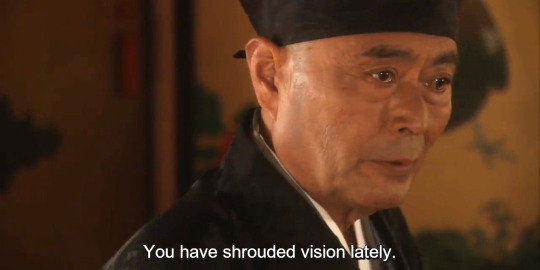











Strategist Kanbei / Gunshi Kanbei (Ep 41)
Sen no Rikyu could no longer hold his tongue after listening to countless of their war councils. Ishida Mitsunari takes the opportunity to slander him, when in reality the temple erected the statue out of respect for Sen no Rikyu who have donated money he earned from holding tea ceremonies for various lords.
I can see why many lords hates him. He's a bootlicker to the Taiko. He wants the Taiko to trust him and no one else. He openly disrespects other lords despite of their loyalty and contributions to the Taiko, which end up having them betrayed, punished or killed.
Ishida Mitsunari deserves what happen to him at Sekigahara.
#strategist kanbei#gunshi kanbei#toyotomi hideyoshi#ishida mitsunari#sen no rikyu#kuroda kanbei#period drama#taiga drama#historical drama#japanese drama#sengoku jidai#jidaigeki#japan#sekigahara#okada junichi#junichi okada#tanaka kei#kei tanaka
13 notes
·
View notes
Text
Danganronpa:Ransei's Tears
read it on the AO3 at https://ift.tt/eh0H1nG
by Spinnetossa_Shipper
After the great Ransei War, it is believed that peace has returned to the region. However, as the 38 Warlords and Junior Warlords suddenly vanish without a trace, peace seems unlikely. Waking up in an unknown environment, these warlords must now fight for their survival. What will it take for these closely bonded warriors to kill once more?...
(This is more of a Pokemon Conquest centric fanfic so you do not need to be a Danganronpa fan to understand this story)
(First Chapter is an authors note and not part of the story)
Words: 187, Chapters: 1/?, Language: English
Fandoms: Dangan Ronpa Series, Pokemon + Nobunaga no Yabou | Pokemon Conquest
Rating: Teen And Up Audiences
Warnings: Graphic Depictions Of Violence, Major Character Death
Categories: Multi
Characters: Shujinkou | Hero (Pokemon), Shujinkou | Heroine (Pokemon), Oda Oichi, Maeda Keiji, Fukushima Masanori, Ishida Mitsunari, Katou Kiyomasa, Toyotomi Hideyoshi, Kuroda Kanbei, Takenaka Hanbei, Mouri Motonari, Chousokabe Motochika, Tachibana Ginchiyo, Tachibana Muneshige, Imagawa Yoshimoto, Shimazu Yoshihiro, Uesugi Kenshin, Naoe Kanetsugu, Aya Gozen, Takeda Shingen, Sanada Yukimura, Kunoichi (Samurai Warriors), Houjou Ujiyasu, Narita Kaihime, Fuuma Kotarou, Nene | Toyotomi Yoshiko, Hattori Hanzou, Date Masamune, Saika Magoichi, Tokugawa Ieyasu, Honda Tadakatsu, Komatsuhime | Honda Inahime, Saitou Nouhime, Izumo no Okuni, Akechi Mitsuhide, Hosokawa Gracia, Mori Ranmaru (Historical RPF), Oda Nobunaga
Additional Tags: Crossover, Killing Game (Dangan Ronpa), Character Death, Original Character(s)
read it on the AO3 at https://ift.tt/eh0H1nG
0 notes
Text
Anyway, I love Takenaka Hanbei
#i have a soft spot in my heart for strategists#kuroda kanbei im looking at you too#kuroda kanbei#takenaka hanbei#mishas adventure with japanology
4 notes
·
View notes
Photo
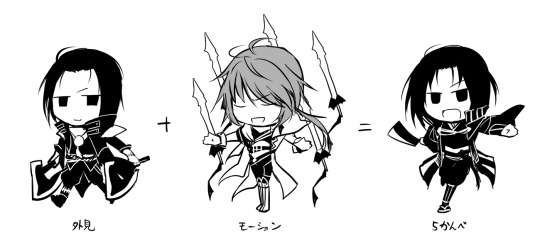
真・三國無双7/戦国無双5 - 賈充・鍾会・黒田官兵衛
7の賈充さんと鍾会さんを遊んだ感想。 性格も足して2で割ったら5官兵衛になるかもしれない。
#dynasty warriors#dynasty warriors8#samurai warriors#samurai warriors5#jia chong#zhong hui#kuroda kanbei#版権
13 notes
·
View notes
Photo
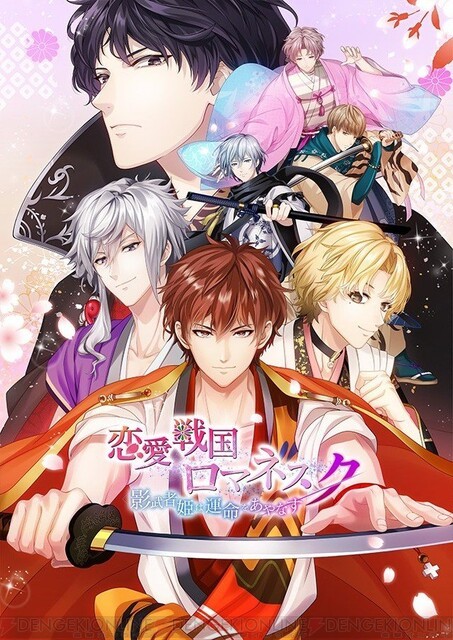
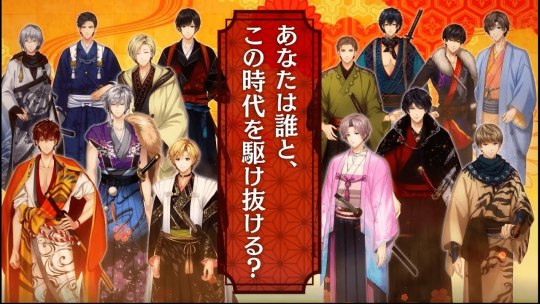
「恋愛戦国ロマネスク ~影武者姫は運命をあやなす~」
Ren'ai Sengoku Romanesque ~ Kagemusha-hime wa Unmei o Ayanasu ~
Website: https://koiroma.renaigame.jp/
Look at the top poster. Which one of those characters is supposed to be Nobunaga, do you think?
If your answer is the menacing-looking black-haired individual at the back, you’re wrong. That’s Shingen. Nobunaga is the one with reddish-brown hair in front.
This romance game app was, well, one of the avant-garde adaptation types. That is, by using “alternate universe/multiverse” as an excuse, they can still keep the Sengoku samurai names and a vaguely Sengoku-esque setting, but forgo history facts beyond the barest of minimum (Shingen being the Tiger of Kai, Nobunaga won against Yoshimoto in Okehazama, and other primary school level minimal facts).
My previous post is also another one of these wild adaptations. I don’t know if the creators thought that the audience are tired of the “old tropes”, or if they just want to run wild and create original fiction, but use the samurai names as clickbait. There are many people who would flock to a product just because a famous samurai’s name is on it.
According to the summary in promotional material, the heroine “timetravelled” from modern Japan into an alternate reality where Nobunaga’s conquest is not entirely successful because Shingen lived and managed to push back against him. Upon seeing the heroine, Nobunaga formulated a strategy where he will release a propaganda saying that “Oda Nobunaga is actually female”, and hire the heroine to play the role of that “fake female Nobunaga”.
I’m not sure how that’s supposed to work, but I imagine from this point on it will just essentially be an original fiction with little to no semblance to actual history.
Whatever happened to change the “history as we know it” also changed the lineup of the clan alliances. For some reason Ieyasu broke off his alliance to Nobunaga, and is now part of the Shingen faction. Hideyoshi is already an indenpendent lord, who seems more or less on equal standing with Nobunaga in this universe, although he didn’t turn into an enemy (as far as I know). He seems to be still “Oda ally”.
The weirdest part of this whole thing is probably Saitou Dousan being not dead and also a romantic option. I mean, naturally he is depicted as a quite handsome man here, but when I think of his usual depiction of a big, bald old man... I'm having a hard time reconciling the two.
”Oda unit”: Oda Nobunaga, Akechi Mitsuhide, Saitou Dousan, Azai Nagamasa
”Toyotomi unit”: Toyotomi Hideyoshi, Katou Kiyomasa, Kuroda Kanbei, Chousokabe Motochika
”Takeda unit”: Takeda Shingen, Uesugi Kenshin, Sanada Yukimura, Tokugawa Ieyasu
“Other”: Saika Magoichi, Tachibanaya (another timetraveller)
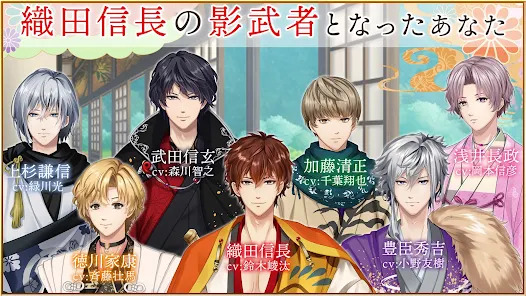
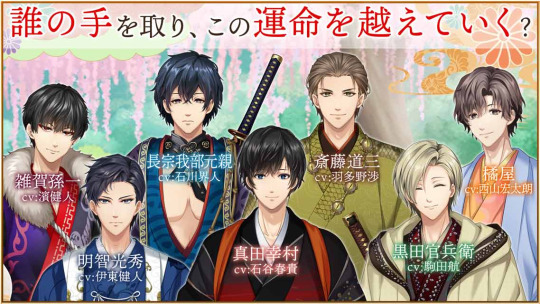
#romance game#romance app#otome game#pop culture#ODA NOBUNAGA#saitou dousan#Saika Magoichi#sanada yukimura#Kuroda Kanbei#Akechi Mitsuhide#toyotomi hideyoshi#Tokugawa Ieyasu#uesugi kenshin#Takeda Shingen#chosokabe motochika#katou kiyomasa#Azai Nagamasa
8 notes
·
View notes
Text


I will forever be rooting and cheering for this guy
24 notes
·
View notes
Photo

#sengoku basara#ishida mitsunari#tokugawa ieyasu#date masamune#sanada yukimura#otani yoshitsugu#saika magoichi#tsuruhime#kuroda kanbei#official render#sengoku basara 3
14 notes
·
View notes
Photo



sw5 doodles
#my art#sw5#samurai warriors#samurai warriors 5#Kuroda Kanbei#shikanosuke yamanaka#戦国無双#戦国無双5#sengoku musou
63 notes
·
View notes